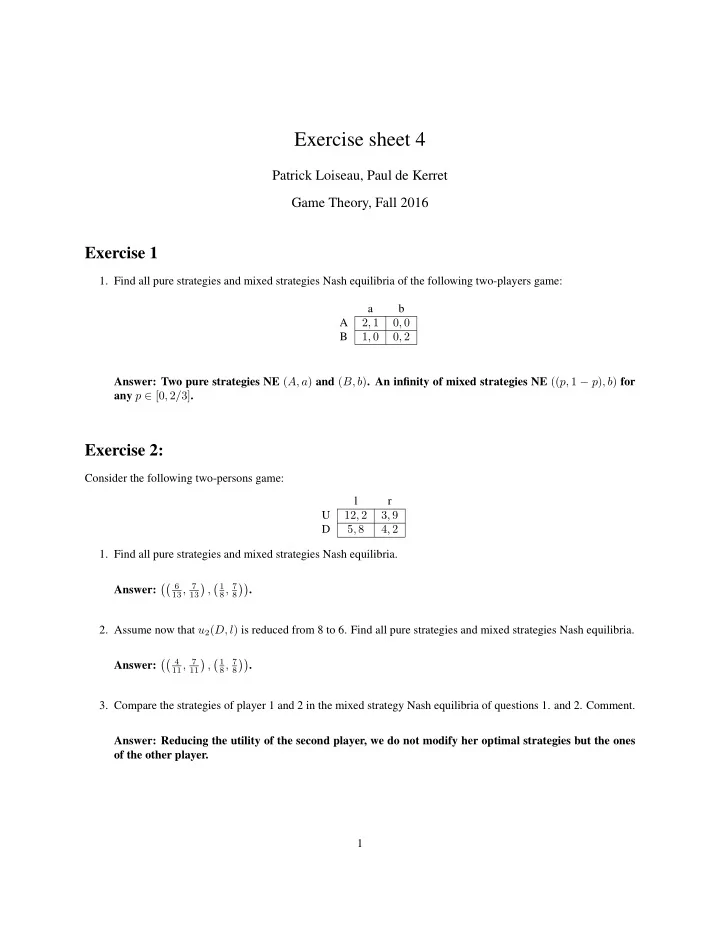

Exercise sheet 4 Patrick Loiseau, Paul de Kerret Game Theory, Fall 2016 Exercise 1 1. Find all pure strategies and mixed strategies Nash equilibria of the following two-players game: a b 2 , 1 0 , 0 A 1 , 0 0 , 2 B Answer: Two pure strategies NE ( A, a ) and ( B, b ) . An infinity of mixed strategies NE (( p, 1 − p ) , b ) for any p ∈ [0 , 2 / 3] . Exercise 2: Consider the following two-persons game: l r 12 , 2 3 , 9 U D 5 , 8 4 , 2 1. Find all pure strategies and mixed strategies Nash equilibria. �� 6 � 1 13 , 7 � 8 , 7 �� , Answer: . 13 8 2. Assume now that u 2 ( D, l ) is reduced from 8 to 6. Find all pure strategies and mixed strategies Nash equilibria. �� 4 � 1 11 , 7 8 , 7 � �� Answer: , . 11 8 3. Compare the strategies of player 1 and 2 in the mixed strategy Nash equilibria of questions 1. and 2. Comment. Answer: Reducing the utility of the second player, we do not modify her optimal strategies but the ones of the other player. 1
Exercise 3: Suppose that player 1’s car is not working properly: it lacks power. He does not know whether it needs a small engine cleaning or a major repair (say, a new engine). The probability that it needs a new laser is ρ . At his local garage, he finds that a new engine costs L , while a cleaning costs C ( L > C ). He knows that the expert at the garage, player 2, gets the same profit π , if she charges him for a new engine and indeed fixes the engine, or if she charges him for a cleaning and indeed just cleans it. But she can make more profit, Π > π if she charges him for a new engine but in fact (secretly) just cleans it. If it only needed a cleaning anyway, then she will get away with this, but she knows she will get sent to jail if she only cleans it when it needed a new engine. The expert is very good at her job, so she knows which is needed. 1. Explain why player 1 should always believe player 2 when she says it just needs a cleaning but why he might be skeptical if she says it needs a new laser. Answer: No game yet. If needs engine, player 2 will say so. Player 1 can reject the local expert’s advice and get a second opinion from a consultant who never lies. Assume however that, if he does so, he must accept the second expert’s advice and accept new repair costs L ′ > L or C ′ > C . The game is then: Honesty Dishonesty − ρL − (1 − ρ ) C, π − L, ρπ + (1 − ρ )Π Always accept advice − ρL ′ − (1 − ρ ) C, (1 − ρ ) π − ρL ′ − (1 − ρ ) C ′ , 0 Reject if told ’new engine’ 2. Explain the terms in the payoff matrix. 3. Assume that L > ρL ′ + (1 − ρ ) C ′ . Is there a pure strategy Nash equilibrium? Answer: No. 4. Find the mixed strategy Nash equilibrium (as a function of the parameters). Π and q = L − ρL ′ − (1 − ρ ) C ′ Answer: p = π L − ρL − (1 − ρ ) C ′ 5. As we increase the cost of repair at the local garage L , what happens to the equilibrium probability that the expert chooses ’honest’? What happens to the equilibrium probability that player 1 chooses ’Reject if told ’new engine”? Comment. Answer: When we increase L , q increases as well, while p is not affected by L . 6. As we increase the profit from lying Π , what happens to the equilibrium probability that the expert chooses ’honest’? What happens to the equilibrium probability that player 1 chooses ’Reject if told ’new engine”? Comment. Answer: When we increase Π , q is not affected, while p decreases. 2
7. It has been said that, in America, when people go to the doctor, they never think they have a cold: they think they have ‘mono’. Assuming this is true, why might we expect doctors in America often to act dishonestly? [Hint: think about how the parameter ρ affects the equilibrium in the above model]. Answer: ρ does not affect p , but q . When we assume ρ bigger, we think that 2 will act honestly, so we are more incentivated to accept. 3
Recommend
More recommend